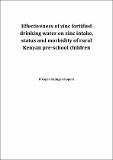| dc.description.abstract | Introduction: Malnutrition and Inflammation are highly and concurrently prevalent in
preschool children in rural Western Kenya, making estimation of those at risk of deficiency
difficult. Different approaches have been proposed to correct nutritional biomarker data for the
effects of inflammation.
Objectives: (1) to assess the impact on population prevalence estimates of zinc, iron and
vitamin A deficiencies of different recently proposed approaches to correct for inflammation
and (2) to investigate the determinants of zinc, iron and vitamin A status in children 2-6 years
old living in rural Western Kenya.
Methods: Iron deficiency was defined as plasma ferritin concentration <12 µg/L and/or soluble
transferrin receptor concentration > 8.3mg; zinc deficiency as plasma zinc less than 65 and 57
µg/dl (collection morning and afternoon, respectively) and vitamin A deficiency as retinol
binding protein levels >0.75 µmol/l. Inflammation was defined as C-reactive protein >5mg/l and
alpha 1 acid glycoprotein >1g/l. Five approaches to correct nutritional biomarkers for
inflammation were compared (a) ignoring inflammation, therefore assessing nutritional
deficiency prevalence without taking into account acute phase proteins, (b) exclusion of
inflamed individuals from the survey, (c) change of nutrient biomarker cut off values for those
with and without elevated APP, (d) four level inflammation correction factors and (e) regression
modelling. Linear regression was used to assess determinants of zinc, iron and vitamin A status.
Results: Zinc deficiency prevalence was 74%, vitamin A deficiency, 34% and iron deficiency
61%. Acute phase proteins were elevated in 53% and 37% of the children (AGP and CRP
respectively). Prevalence estimates varied for all nutrient biomarkers depending on approach
used to correct for inflammation: percent decrease range for zinc and vitamin A deficiency was
2%-19% and 43-78% respectively. Iron deficiency prevalence increased by range 0.6-3.6% by
all other approaches except exclusion where it decreased by 10%. Fasting status, household
size, alpha 1 acid glycoprotein, hemoglobin, and retinol binding protein concentration were
significant predictors of PZn status. The age of child, C-reactive protein and alpha 1 acid
glycoprotein concentration were significant predictors for plasma ferritin levels. Whilst plasma
zinc, hemoglobin and C reactive protein concentrations were significant predictors of retinol
binding protein levels.
Conclusions: Zinc, iron and vitamin A deficiencies as well as inflammation were high in the
Kenyan preschool children assessed. Regardless of the approach used in this population, for
high prevalences above global thresholds there was no substantial difference in Fe and Zn
deficiency prevalence hence correction is not required in such instances to determine the public
health relevance of a nutritional deficiency problem. | en_US |

